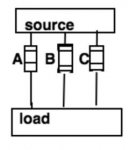Designer69
Senior Member
please see attached screen shot.
The question is something like this... System is WYE-Grounded. The voltages are 480V. Fuse B blows. What are the voltages now?
a) A-0 B-480 C-0
b) A-0 B-277 C-0
c) A-277 B-0 C-277
d) A-480 B-0 C-480
The question is something like this... System is WYE-Grounded. The voltages are 480V. Fuse B blows. What are the voltages now?
a) A-0 B-480 C-0
b) A-0 B-277 C-0
c) A-277 B-0 C-277
d) A-480 B-0 C-480





